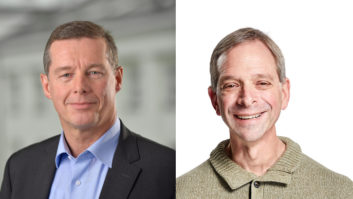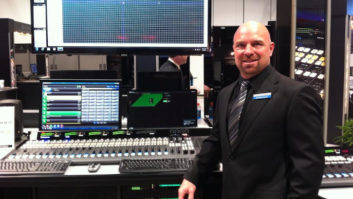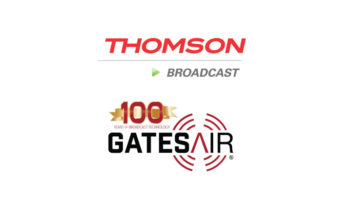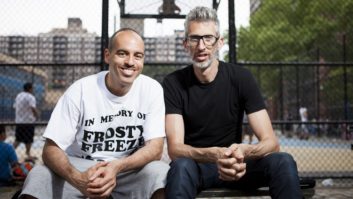
The spring NAB Show is approaching. Between now and then Radio World will conduct several short Q&As with manufacturers about their plans and offerings, to help you get the most out of the big annual trade show. Rich Redmond is chief product officer for GatesAir.
Radio World: How has business been for the company since last year’s NAB Show?
Rich Redmond: The last 12 months have been an exceptionally strong year for us in radio. We have had big deals with Cumulus and other U.S. broadcasters, including mid-sized groups like Zimmer Radio Group. We’ve seen interest in our higher power liquid-cooled transmitters at FM stations where cooling costs were a particular concern. Internationally, we’ve seen additional DAB radio business in Europe and Asia, HD Radio in Asia, and FM Radio investment in the Middle East and North Africa. We recently signed a very large deal in Egypt to upgrade existing FM infrastructure. So globally, it’s safe to say that a growing number of radio broadcasters are looking at their existing infrastructure and deciding it’s time to make significant upgrades.
It’s important to note that our TV business has been growing globally. We’ve had major DVB-T2 deals in Russia, India and Africa recently. We are beginning to see investment from U.S. TV stations preparing for the spectrum repack, and we have unveiled a new range of transmitters to optimize channel changes across UHF and VHF bands. These transmitters are also ATSC 3.0-ready, which is the next big business opportunity we are looking a stateside.
RW: What are you hearing from your customers about their business outlook this year? In what areas should we expect growth or the most interesting projects?
Redmond: Looking especially at radio, we continue to see a transition to more IP contribution and distribution networks. This includes your classic point-to-point STLs, as well as wider-area networks for sharing content across many stations. Internationally, DAB radio networks are adopting EDI for IP transport. So, we expect to see a lot more growth here, which is one reason why we recently established a dedicated division for our Intraplex business. We’re investing in new products and technologies to help our customers address these opportunities.
On the transmission side, the TV repack will affect FM broadcasters that collocate on common towers. We believe that we will see some interesting projects around FM broadcasters that need to make quick changes based on repack-driven TV tower work, including temporary relocation to auxiliary transmitters and/or sites. We are well-prepared to help our customers navigate these changes.
RW: How has IP technology affected your company?
Redmond: IP technology is pervasive. It is the present as much as it is the future. But, that doesn’t mean everything out there is reliable when it comes to IP technology. As an industry, we need to continue to innovate more robust, reliable IP solutions for AM, FM and digital radio transport and delivery. This is what we continue to work on with our Intraplex line.
We’ve made some significant headway. Look at control and monitoring, and how that has accelerated away from parallel wires running to and from a remote control. Today, we have seamless integration to browsers and mobile devices, with SNMP capability to connect over an IP network. We’ve developed a strong partnership with Burk Technology around these innovations, helping out customers bypass the cumbersome wiring schemes of the past for control and monitoring.
RW: The company (through its predecessors) has been active in the radio equipment market for decades, what’s the biggest problem or challenge facing the radio broadcast equipment market these days?
Redmond: The decline in experienced RF broadcast engineers remains a concern. Our customers are becoming more stretched due to a lack of time and resources. There are fewer and fewer engineers in the industry with strong RF backgrounds. So, it’s pertinent that we continue to make their jobs easier, partially by helping these customers move away from labor-intensive tube systems to more efficient, single-engineer solid-state platforms that minimize maintenance and just plan work.
RW: What new goodies will your company be showing? Why should attendees visit your booth?
Redmond: At Booth N2613, visitors will see some new products and recent innovations introduced over the last 12 months. These all represent our continued product strategy built around solving problems for our customers, and advancing the possibilities of wireless over-the-air content delivery. For FM transmission, all of our latest Flexiva transmitters will be on displays, from our lower-power Flexiva LX FM products announced last year, to our FLX liquid-cooled systems for FM and HD Radio.
Intraplex will show several new innovations, including the industry’s first professional solution for moving analog and digital composite signals over IP networks from a common platform. That product, the IP Link MPXp, vastly reduced the bandwidth requirements for moving digital composite over IP, which is a significant development. It’s a far more superior alternative to using distributed stereo generators. We’ll also show a new software application, IP Connect, to strengthen data transport across IP networks, including more complex architectures like E2X (exporter-to-exciter) connections where packets are more easily dropped.
RW: With the sale of the PR&E line will that allow for a deeper focus on the core technologies of transmission and signal traffic routing?
Redmond: Absolutely. It was important for us to find the right home for the PR&E business. We had built up a significant customer base over the years, and developed the PR&E line to a point where a company like Wheatstone, which is very invested in the studio business, can take this foundation we have built and propel it forward. I think the industry will see a lot of innovation behind the PR&E brand moving forward. And there is no question that it allows us to put a strong emphasis on developing our business focus beyond the studio.
RW: What do you anticipate will be the most significant technology trend at the 2017 NAB Show?
Redmond: Broadcasters have adapted to consumers that want to listen to media on the device of their choosing, and many technology innovations are addressing this continuing trend. Radio really owns the market for live and local content. We’re helping broadcasters address this with FM translators, whether coupling them with HD2 channels or to strengthen local AM stations. We’re also making it easier to connect these systems with streaming services and IP delivery mechanisms. It’s about helping our customers distribute more content over multiple delivery platforms.
RW: There’s been some considerable rearranging of booths over the last couple of years when it comes to radio industry companies, how do you like the new hall/floor layout?
Redmond: We have been near the entrance of North Hall for most of the past 15 years, besides one trip to Central Hall two years ago. We like the North Hall because it’s an ideal position for attracting both TV and radio customers, based on other exhibitors that call it home. Being there has always worked out well for us.
RW: Will you be attending any sessions or looking forward to any events?
Redmond: We will certainly have our hands full with presentations and panels. I’ll be speaking on an ATSC 3.0 TV panel on Tuesday at 11:30 a.m.; at the same time, GatesAir will feature prominently on a sustainability panel for the NAB Show Live panels taking place out in the commons area between North and Central Hall. Our engineers will be delivering several other papers through the show, across radio and television. And overall, there is certainly a lot of excitement around the spectrum repack, including its impact on FM radio stations; as well as advances in IP and multichannel, multiplatform delivery. I’ll be keeping my eye on sessions related to these topics, and hope to attend a few when possible.
RW: You’re a show veteran, what’s your favorite thing about the show? Least favorite thing?
Redmond: It always comes down to catching up with people you don’t usually see face to face. There are many of us in the industry who live in Cincinnati but we only seem to see each other in Las Vegas. It’s a luxury to have that opportunity to see so many people from around the globe in one place. Least favorite thing: the show is probably one day too long. The drop-off in traffic from Wednesday to Thursday grows more noticeable by the year.
For more NAB Show-related news and features check out our NAB Show News page.












